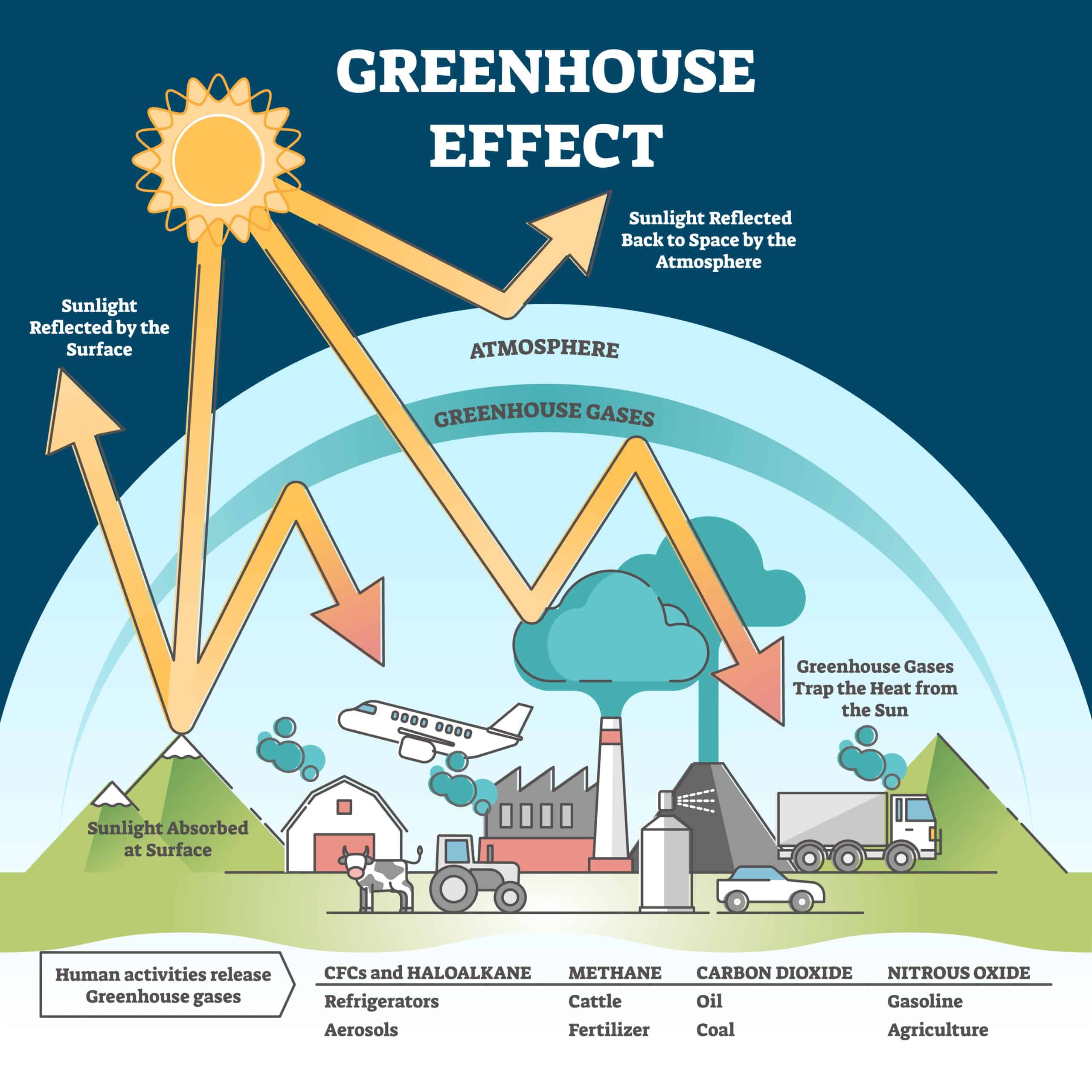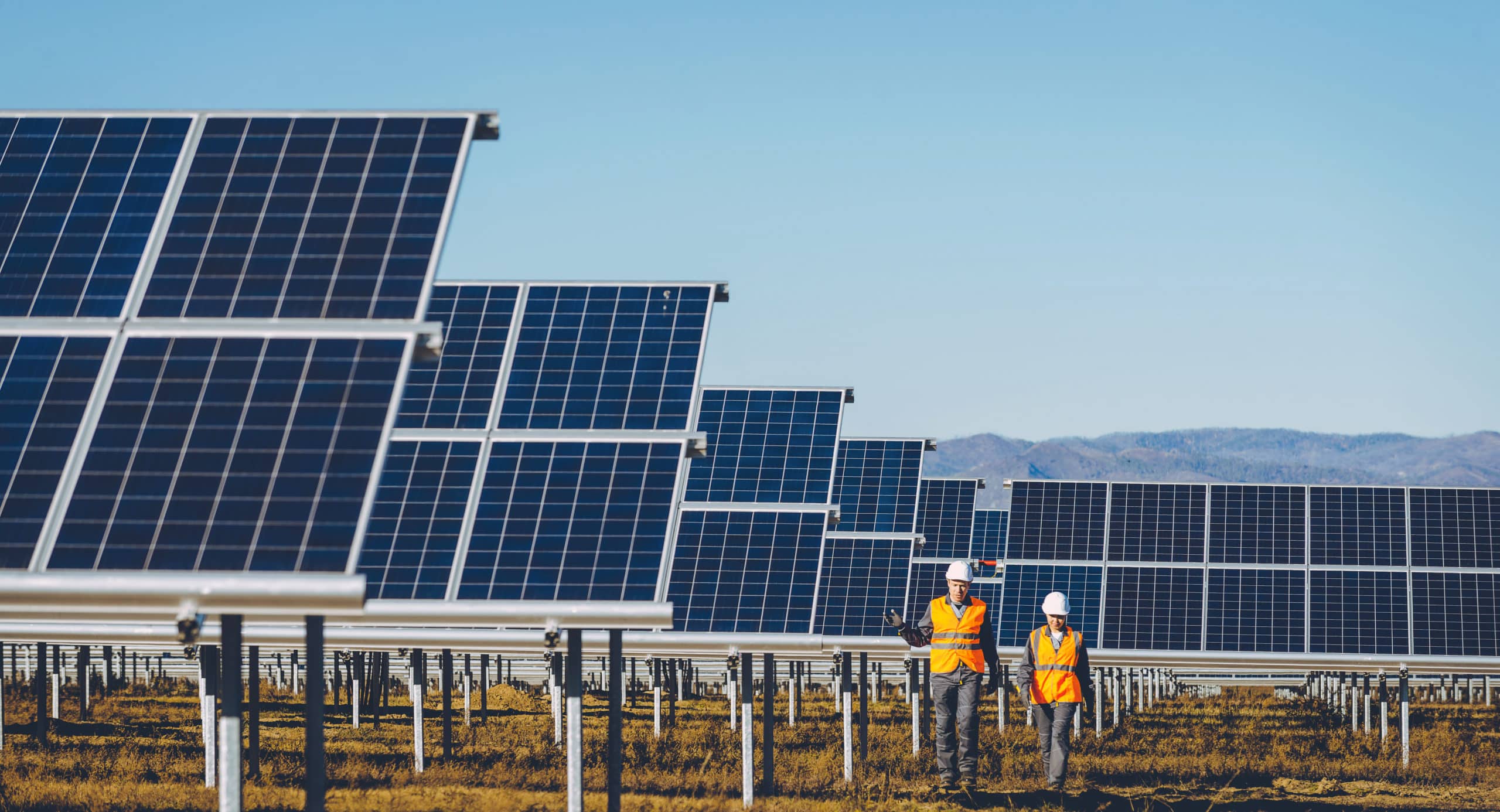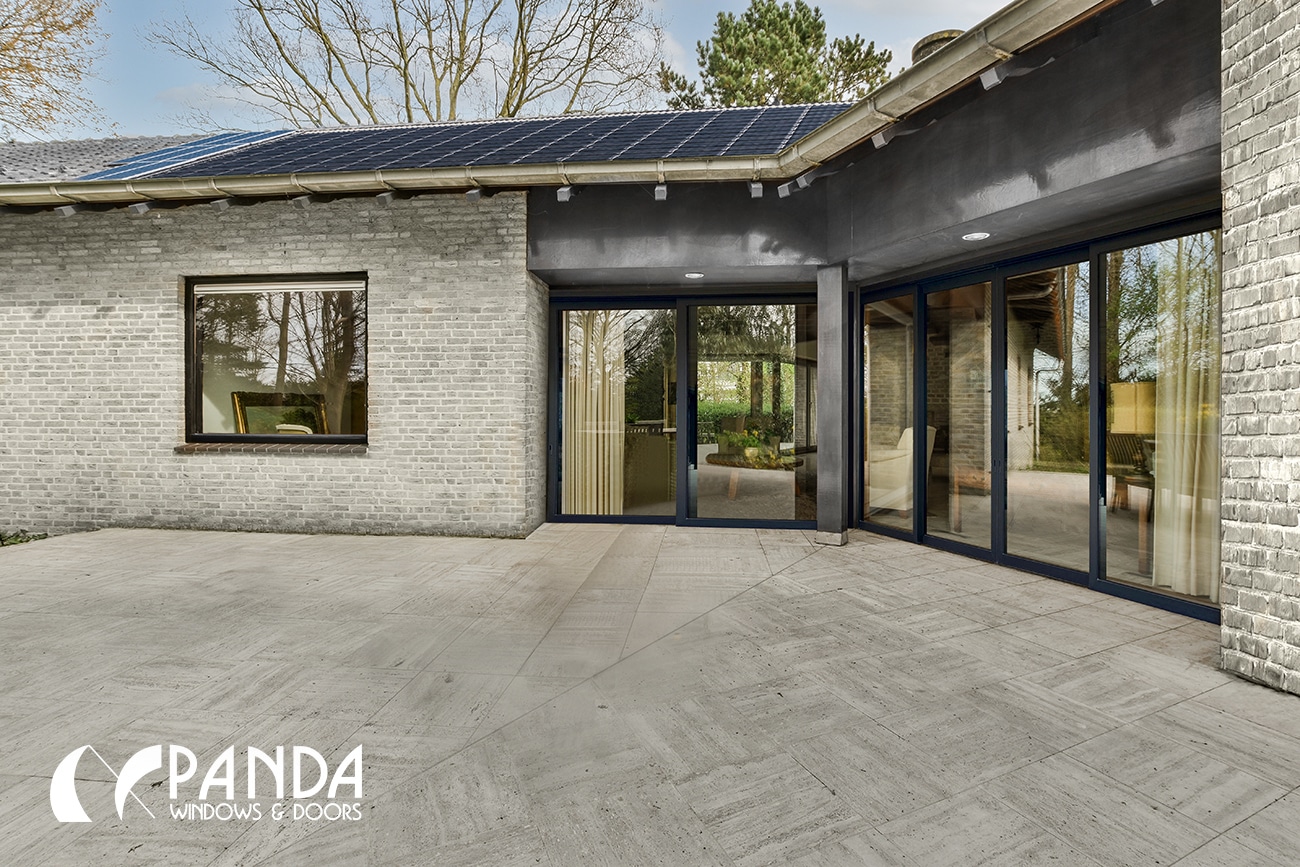Solar Powered Living: A History and Practical Use of Solar Energy in Architecture
December 7, 2022
A Ghastly Effect
Earth is essentially a greenhouse. And with the interference of human activity including the extreme rate at which fossil fuels are burning, our greenhouses gases are on the rise. Essentially the planet’s resources are being burned off at an alarming rate and having a domino effect on every corner of the globe. Ice caps are melting, sea levels are rising, water reserves are drying up and dry brush is catching fire. This climate change is a direct result of the Greenhouse Effect.
The greenhouse effect is a trend that was identified by scientist as far back as 1896. This phenomenon is actually a positive thing for the planet. It is what happens when the atmosphere traps heat radiating from the Earth’s surface towards space and helps to regulate the Earth’s temperature to a comfortable medium and keeps it from freezing over—in instances like the Ice Age. The most common gases responsible for this include carbon dioxide, methane, nitrous oxide, water vapor, and fluorinated gas.
With some of these gases permeating in the universe, it makes it nearly impossible for heat to escape. However, everything is best in moderation. Due to mankind’s aggressive push towards modernity and valuable resources being burned off, our greenhouse gases keep growing, and the Earth has been getting hotter each year. This can all be attributed to population size, economic activity, lifestyle that do not promote sustainability, energy use.

Energy Efficient Alternatives
With global warming rapidly taking its toll on the Earth, it is only natural that we ask, “How can we fix this?” Efforts have been slowly shifting towards more sustainable and energy efficient ways of life. Energy efficiency is a method of using less energy to do the same task that would otherwise harm the environment, but receiving the same results. It is one of the easiest and most cost-efficient ways of combating climate change. Two of the main methods the U.S. uses to conserve energy are through the utilization of wind power and solar power. But for now, let’s focus on the power coming straight from our solar system.

Solar Energy
Solar energy, or photovoltaics, is the utilization of the sun’s power as a source of renewable energy. Although it’s a bit of technology we have not yet fully harnessed as out primary source, the idea of solar energy has been around for quite some time—as early as 7th century B.C. Humans were said to have used sunlight to light fires with magnifying materials.
Later, Greeks and Romans were known to use mirrors to light torches for religious ceremonies (Chinese civilizations were also said to use these “burning mirrors”). Then, in the 1200’s A.D., ancestors to the Pueblo Native Americans—The Anasazi—would build their abodes on cliffs facing the North to capture the sun’s warmth during cold winter months. But it would be until the late 1700s and 1800s that scientists used the sun’s energy to power ovens on long voyages, then to power steamboats—this was before the creation of the solar panel.
A History of Solar Power
While there is some debate as to when exactly the technology for solar panels was developed, some credit it to French scientist, Edward Becquerel. Becquerel concluded that light could increase electricity generation when two metal electrodes were placed into a conducting solution. This was called the “photovoltaic effect: the process of generating voltage and electric current in a photovoltaic cell.
In 1873 Willoughby Smith, chief electrician of the Gutta Percha Company, published an article in the Journal of the Society of Telegraph Engineers about his discovery of photoconductivity in the element selenium. He was using bars of the selenium as a detector for flaws in the transatlantic cable before submersion. Smith attributed their energy output to the sun hitting them, so he placed the bars in a sealed box and found that the flow of energy remained constant. Once he removed the box’s lid, he found its energy increased with the absorption of more sunlight.
This later aided British scientists, William Grylls Adams’ and Richard Evans Day’s 1876 discovery. Their findings found of electricity created from selenium when exposed to the sun. The two put selenium through an extensive series of test including experiments in thermal electricity, but concluded the sun to be the greatest factor in the materials reactivity.
In 1883 Charles Fritts produced the first solar cells made from wafers of selenium placed onto a metal plate and covered in a thin semitransparent layer of gold leaf, which produced a current. Fritts stated that the current, “is continuous, constant, and of considerable force [,]…not only by exposure to sunlight, but also to dim diffused daylight, and even to lamplight.” This is the reason some credit Fritts as the inventor of solar cells. It was found that selenium showed high absorption coefficient and mobility, making it an attractive absorber for high bandgap thin film solar cells.
However, because Fritts and his supporter, Werner von Siemens, didn’t know exactly how the invention worked, it was written off by the scientific community and not valued for further research. A host of other scientists and brilliant minds including George M. Minchin, a professor of applied mathematics at the Royal Indian Engineering College, Albert Einstein and Dr. Bruno Lange, a German Scientist, would further the development of understanding of solar energy, but to not much success.
With the rise in popularity of silicon as a source material, the first practical solar panels were created alongside the creation of the silicon transiter, a creation used in many modern technological devices. The silicon photovoltaic cell was created by Daryl Chapin, Calvin Fuller, and Gerald Pearson at Bell Labs in 1954. In 1981, the first aircraft to run on solar power, The Solar Challenger, was built by Paul MacCready.
With the price of solar power having dropped substantially over the last few decades, the demand for this renewable energy has skyrocketed. In 1956, solar panel installation could cost around $300 a watt, compared to today where a solar panel can cost as little as $0.50 a watt and making energy efficient buildings more accessible.

Solar Powered Architecture
With solar power technology being near perfected, and the price of such technology becoming so affordable, it is now common for architects and designers to consider this renewable energy source from the earliest planning phases of construction all the way to the solar power installation. This allows architects and designers to accurately predict how much of a power source will be needed to fuel the site.
Solar Analysis in Architecture
Solar analysis is a process during the design and planning phase of solar powered architecture that analyzes how much of the sun’s energy hits your site; not how much lightness there is in the room. Using Solar Study, a designer can create an animated study or still image that visualizes the sun’s path and shadows that a site casts during a specific time of day. Then, the solar analysis visualizes and quantifies the spread and intensity of solar radiation onto the site. This aids in the planning of solar panel placement for maximum energy gain when doing a solar installation. This is a direct utilization of solar panels as a means of producing energy as opposed to say, passive solar architecture.

Passive Solar Home Design
A passive solar home is a method of solar architecture in which the home collects heat as the sun shines through south-facing windows and retains it in materials that store heat, known as thermal mass. The share of the home’s heating load that the passive solar design can meet is called the passive solar fraction, and depends on the area of glazing and the amount of thermal mass. The ideal ratio of thermal mass to glazing varies by climate. Well-designed passive solar homes also provide daylight all year and comfort during the cooling season through the use of nighttime ventilation.
Solar Powered Buildings Changing Architecture
The solar industry is changing the way we see architecture. Solar architecture is the way of the future, and many architects are stepping into the solar industry and are using solar architecture to craft jaw dropping structures with an emphasis on energy efficiency. Below are a few examples of building structures that are making big strides in the solar industry.

- Apple’s Spaceship Headquarters (a.k.a. The Spaceship)
- A $5 billion headquarter in Cupertino, California will contain the largest pieces of structural glass ever made as well as one of the largest solar rays for a corporate building in the world. The technology giant is installing solar panels with an estimated output of 16 megawatts of power. The campus will also feature 4 megawatts of biogas fuel cells and source additional renewable energy from a nearby 130-megawatt solar installation from First Solar. In addition to renewables, Apple is also adding 2,500 new and indigenous trees, groundbreaking sustainable architectural design elements, and miles of biking and jogging trails. In total, the 175-acre campus will be 80 percent green space.
-
- Melbourne’s off-grid skyscraper
- A new 60-story apartment building slated for Melbourne’s skyline is aiming to offer future residents an alternate way of living than the usual grid connected systems. To achieve this, Peddle Thorp Architects have designed a building with a facade wrapped in solar cells and complemented with roof-mounted wind turbines, sustainable architectural design and a massive battery storage system. Called Sol Invictus (“invincible sun”), the building will be oriented to give its curved exterior the ability to capture as much of the sun’s east-to-west movement as possible. “This concept would see the technology shaping a fundamental part of the architecture,” architect Peter Brook from Peddle Thorp told Curbed. “Many designers engineer building structures to reduce their exposure to the sun. In this case, we’re doing the opposite.” According to Brook, leveraging solar panels in the facade as opposed to the roof allowed the designers to expand the square footage available for a renewable source of power from 4,305 square feet to 37,673 square feet. While that number will offset roughly 50 percent of the buildings energy needs, the designers are hopeful that gains in efficiency and other improvements will move that number closer to 100 percent when the project is completed in the next three or four years.
- Melbourne’s off-grid skyscraper
- General Electric’s ‘solar veil’ HQ
- As a tribute to Boston’s maritime heritage, GE’s new sustainable headquarters overlooking the city’s Fort Point Channel will include a dramatic solar veil. According to Boston Magazine, the veil will be “composed of solar slats that will let light through, but not before it bounces off their photovoltaic surfaces.” In addition to repurposing two old brick warehouses on the 2.4-acre site, GE also will install native plantings, rooftop gardens, and, as a sign of things to come, elevated ground floors and critical systems to account for future sea level rise. To encourage the use of mass transit, biking or walking to work, the site will feature only 30 parking spots for its expected 800 employees. After completion sometime in 2018, GE expects its HQ to be certified as one of the greenest buildings in the U.S.
- Tesla’s Gigafactory
- Tesla’s Gigafactory in Nevada, the future battery-production centerpiece of its electric car empire, is not only the world’s largest building by physical area (with a factory footprint of 126 acres), but also a net-zero energy facility. According to CleanTechnica, the company decided from the start not to build a natural gas pipeline to the factory as a way of “forcing it” to rely on renewables. The current plan involves not only covering the entire roof in solar panels, but also installing arrays in the neighboring hillsides. If that doesn’t fully meet the facility’s demands, Tesla Motors CTO JB Straubel says they’ll just have to figure something out. “So it’s kind of been a fun activity and just, a lot of challenges that come up,” he recently shared. “But in every single step of the process, we have been able to reinvent and come up with solutions.” In addition to solar installations, Tesla plans on capturing complementing clean energy from on-site geothermal and wind installations. The site is currently on track to become full operational by 2020.
- Copenhagen International School
- Once it’s completed in 2017, the Copenhagen International School in Denmark will feature the world’s largest solar facade. The more than 12,000 colored solar panels, integrated directly into the building material and structure, will produce half the energy needs of the school (around 300 megawatt hours per year). In an effort to engage the 1,200 students with the facility’s clean energy features, “solar studies” will be integrated into the curriculum. This will allow students to monitor energy production in real-time for use in classes like physics and mathematics. “We are proud that with the construction of the new school we can integrate innovative architecture into our teaching principles. The goal of the school is to enhance students’ competences in an international environment so that they become responsible citizens of the world with a focus on sustainability,” Brit van Ooijen, Chairman of the Board of Copenhagen International School, said in a release.

Panda and Energy Efficiency
At Panda Windows and Doors, we value innovation, top performance and energy efficiency. With our all aluminum thermally broken line of doors, you can save on your home’s energy cost, by allowing our systems to help regulate the temperature in your home by creating a barrier between inside and outside. The thermally broken systems prevent the flow of thermal energy and provides protection against the elements allowing you to save energy and add a luxurious touch to your solar architecture home.
These glass sliding doors blur the lines of interior and exterior spaces and are ideal for opening up large expanses – perfect for parties and entertainment. Then, when it’s time to close up for the night, our contemporary door systems provide protection from burglary, theft and the elements outdoors. Our slim profile systems are durable and made of 6063-T5 extruded aluminum. These glass walls protect your energy efficient home from inclement weather and corrosion even with day-to-day use.
The Panda Lift & Slide style sliding doors are one of the best options when looking to maximize weather resistance in the coldest or warmest climates. With a unique system of levers and wheels, this mechanism creates an airtight seal to keep your home at a comfortable climate regardless of the elements outside. With this temperature regulated addition to your home, you can spend less money on heating or cooling cost and more time enjoying your ideal indoor environment.

These sliding glass walls offer a frameless option giving you a virtually unobstructed view of the world outside your walls. This lets in more sunlight during the cooler months to warm up your space without relying on your heating and cooling system.
With our Horizontal Sliding Walls, a thermally broken system lets this energy efficient door stand up to the harshest of climates. These glass walls come with a thermally broken aluminum option and a thermally broken aluminum/ wood-clad option that helps you save energy.
French doors—also called egress or terrace doors—are a timeless option for your home. With our aluminum based French Doors, your system is guaranteed to be durable, lightweight and weather resistant – even with repetitive daily use. And with our Low-E glass, which is standard for most of our systems, you reduce energy cost by letting in the sunlight, but keeping out the heat that comes with it.
Q&A
- What energy efficient door options does Panda offer?
- Panda offers a variety of thermally broken systems in a myriad of styles including our Multi-Slide Doors, Lift & Slide Doors, Horizontal Sliding Walls and French Doors. These select systems help regulate the climate in your home and helps to keep heating and cooling costs low.
- Is it expensive to switch to solar energy?
- Thanks to major advancements in photovoltaic technology, the cost to produce solar panels has plummeted drastically, making it an affordable energy saving solution in solar architecture.
- How do energy and architecture come together?
- Using a process called Solar Analysis, architects begin to consider solar energy a factor of design when planning building and sites. The amount of sunlight a site gets and what angle it hits the desired location, has a large influence on how the structure is built and where solar panels are placed and how many would be needed to sufficiently power a home or build.
- What is solar passive architecture?
- Passive solar architecture, doesn’t utilize a solar panel system to convert light into power, but instead utilizes south facing windows to allow light and heat in, then traps them with the materials the building was constructed with.
Contact us today to learn more about how we can help make your home energy efficient with our doors and windows.

Doors & Windows with Smart Glass Technology | Cost, Pros & Cons
Discover the advantages of smart glass technology for doors and windows, including costs, pros, and cons, in our detailed overview.

Doors & Windows with Triple-Glazed Glass | Cost, Pros & Cons
Explore the cost, pros, and cons of doors and windows with triple-glazed glass to enhance your home’s energy efficiency in our guide.

Bespoke Aluminum Folding Door with Glass | Features & Price
Learn the features and pricing of bespoke aluminum folding doors with glass for your modern home.











